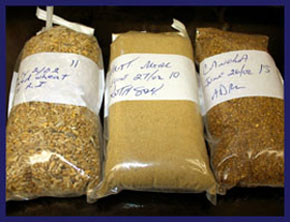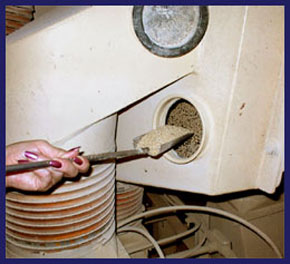Introduction
The target weights for the different breeds are based on recommendations provided by the primary breeders. Poults are fed according to the program and rations formulated for their respective needs.
At the beginning of each flock you will receive a target growth curve. The growth curve is made by plotting the target weights against the age of the flock on a graph. As you weigh the flock each week, plot the average weight of your flock on the graph. From placement to week 6, BUTA hens receive a ration change based on the age of the flock.
|
From week 7 onward, if your flock is above the target line, you should change diets the next time you order feed. If your flock is at or below target, you should change diets according to the age of the flock as outlined in the sections below. Hybrid hens are fed by age up to and including week 8. At present, Nicholas hens are fed according to the HYBRID program.
Feed changes, after the 5th week will be made according to % weight vs target weight.
The first rations of each program and when they are fed are summarized in the following table:
|
Feed from one side of the feed bin at a time. Allow the half bin to empty out before switching to the other side. When you order feed, continue feeding out of the side you were on until it is empty before switching sides.

|
Adjust the feeders so that there is enough feed in the pans that the birds can get at it easily, but not so much that birds knocking against the feed pan will spill it onto the floor.
Adjust feeders regularly to maintain them at a proper height. In general the bottom of the feeder should be kept level with the birds’ backs.
Feed should always be available to the birds. However, it is a good idea to turn your feeders off at night to avoid accidental spills while no one is around to detect them. The birds are fairly inactive at night, and the feed in the pans should last until the next morning.
Record feed on hand by barn on the same day each week. |
Whenever you eat, you start the digestive process by chewing your food. By manually breaking down the food, you allow more of the food surfaces to be exposed to digestive enzymes and acids as it progresses down your digestive tract. Since turkeys do not have teeth, they cannot chew their food. Instead, as part of their digestive system they have an organ called the gizzard. The gizzard is very muscular and has a thick abrasive lining. When the gizzard contracts, it breaks down the food that is inside it. The food passes from the gizzard into the small intestine where the process of extracting the nutrients from the feed begins.
If the food is not completely broken down before it leaves the gizzard the bird may not be able to extract the full nutrient value from the feed. In the wild, turkeys eat small stones which pass down the digestive tract and lodge in the gizzard.
When the gizzard contracts, the stones and the feed grind together resulting in the feed being “chewed”.
|
Obviously, your flock will not be able to pick up small stones from the ground. That is why you need to add grit to the feed starting from one day of age. Add chick size grit to the feed by mixing 5 lbs. of grit with a wheelbarrow of feed.
Use this mixture when you top up the feeders as part of your daily activities. When the birds are one week old, add the grit directly to the feeders once a week at the rate of 10 lbs./1000 birds. Switch to grower size grit when the birds are 14 days of age.
Add grit more often if you feel the birds are looking rough or are not eating as much as they should. The extra grit may help stimulate their appetite.

|
